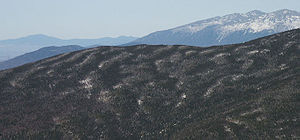
Fir wave
Encyclopedia

Fir
Firs are a genus of 48–55 species of evergreen conifers in the family Pinaceae. They are found through much of North and Central America, Europe, Asia, and North Africa, occurring in mountains over most of the range...
tree
Tree
A tree is a perennial woody plant. It is most often defined as a woody plant that has many secondary branches supported clear of the ground on a single main stem or trunk with clear apical dominance. A minimum height specification at maturity is cited by some authors, varying from 3 m to...
s in sequential stages of development, observed in forest
Forest
A forest, also referred to as a wood or the woods, is an area with a high density of trees. As with cities, depending where you are in the world, what is considered a forest may vary significantly in size and have various classification according to how and what of the forest is composed...
s on exposed mountain
Mountain
Image:Himalaya_annotated.jpg|thumb|right|The Himalayan mountain range with Mount Everestrect 58 14 160 49 Chomo Lonzorect 200 28 335 52 Makalurect 378 24 566 45 Mount Everestrect 188 581 920 656 Tibetan Plateaurect 250 406 340 427 Rong River...
slopes in several areas, including northeastern North America
North America
North America is a continent wholly within the Northern Hemisphere and almost wholly within the Western Hemisphere. It is also considered a northern subcontinent of the Americas...
and Japan
Japan
Japan is an island nation in East Asia. Located in the Pacific Ocean, it lies to the east of the Sea of Japan, China, North Korea, South Korea and Russia, stretching from the Sea of Okhotsk in the north to the East China Sea and Taiwan in the south...
. Fir waves develop by wave-regeneration following wind
Wind
Wind is the flow of gases on a large scale. On Earth, wind consists of the bulk movement of air. In outer space, solar wind is the movement of gases or charged particles from the sun through space, while planetary wind is the outgassing of light chemical elements from a planet's atmosphere into space...
disturbance
Disturbance
In ecology, a disturbance is a temporary change in average environmental conditions that causes a pronounced change in an ecosystem. Outside disturbance forces often act quickly and with great effect, sometimes resulting in the removal of large amounts of biomass...
, and is one of various types of patterned vegetation
Patterned vegetation
Patterned vegetation is a vegetation community that exhibits distinctive and repetitive patterns. Examples of patterned vegetation include fir waves, tiger bush, and string bog. The patterns typically arise from an interplay of phenomena that differentially encourage plant growth or mortality...
.
How fir waves form
Fir waves form by the ecologicalEcology
Ecology is the scientific study of the relations that living organisms have with respect to each other and their natural environment. Variables of interest to ecologists include the composition, distribution, amount , number, and changing states of organisms within and among ecosystems...
process of wave-regeneration. When a tree falls, a gap
Gap (ecology)
In forest ecology, a treefall gap is an opening in the forest canopy structure devoid of large trees. Gaps are formed after large trees die and fall which allows the regrowth trees and other plants as the shade is removed.-References:...
in the canopy is formed. This exposes trees at the leeward edge of the gap to greater wind. These trees are thus more likely to die from damage and desiccation than windward trees. These leeward trees eventually die, gradually expanding the gap downwind. At the same time, young trees start to grow in the wind shadow in the windward portion of the gap, protected from the high winds by the surviving trees. The combination of dying trees at the leeward edge and regenerating trees at the windward edge results in the propagation of the fir waves in the direction of the predominant prevailing wind. The period of the waves is variable, typically about 60 years in Balsam Fir
Balsam Fir
The balsam fir is a North American fir, native to most of eastern and central Canada and the northeastern United States .-Growth:It is a small to medium-size evergreen tree typically tall, rarely to tall, with a narrow conic crown...
(Abies balsamea). One can view these from the Appalachian Trail as it ascends the Hunt Spur of Mount Katahdin
Mount Katahdin
Mount Katahdin is the highest mountain in Maine at . Named Katahdin by the Penobscot Indians, the term means "The Greatest Mountain". Katahdin is the centerpiece of Baxter State Park: a steep, tall mountain formed from underground magma. The flora and fauna on the mountain are typical of those...
. Looking out to the Owl and the Brothers are extensive areas of this phenomenon.

